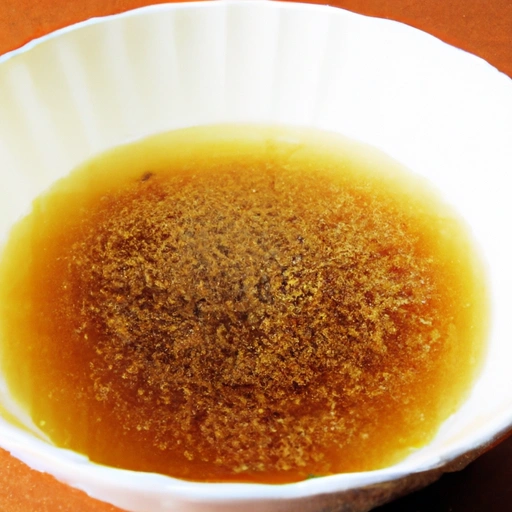Dashi
Description

Dashi is a fundamental ingredient in Japanese cooking, acting as a base for soups, broths, and various sauces. This clear yet flavor-packed liquid is typically made by simmering edible kelp (konbu) and shavings of preserved, fermented skipjack tuna (bonito flakes or katsuobushi) or sometimes dried sardines (niboshi). The result is a savory broth rich in umami, the so-called 'fifth taste' that adds depth and complexity to dishes.
Measurements for preparing dashi may vary, but a common ratio for the most basic dashi using konbu and katsuobushi would be about 5 grams (0.18 ounces or roughly 1 piece) of konbu and 20 grams (0.7 ounces) of katsuobushi per 500 milliliters (about 17 fluid ounces or 2.1 US cups) of water.
Common uses
Dashi is commonly used as a base for miso soup, clear broth soups, noodle broths like those found in udon and soba, and various simmered dishes (nimono). It's also an essential component in dipping sauces (tsuyu) for noodles and tempura as well as a secret ingredient in many Japanese marinades, rice dishes, and even some desserts.
Nutritional value
Calories
Dashi is low in calories, providing a minimal amount depending on the concentration of the broth.
Protein
It contains a modest amount of protein, primarily from the bonito flakes or other fish products used.
Fat
Dashi is virtually fat-free, especially when made traditionally with just konbu and katsuobushi.
Carbohydrates
The carbohydrate content in dashi is negligible unless additional ingredients such as mirin or sugar are added.
Vitamins
While not a significant source of vitamins, dashi may contain small amounts of vitamins B and D, especially if made with fish products.
Minerals
Dashi can be a good source of iodine from the kelp and also contains trace amounts of minerals like magnesium, calcium, and phosphorus.
Health benefits
As a low-calorie, low-fat ingredient, dashi supports healthy eating habits and weight management. The presence of umami can satisfy the palate, potentially reducing the need for added salt. The amino acids present in the bonito flakes are believed to help with blood pressure regulation and overall cardiovascular health.
Potential risks
Overconsumption of dashi, particularly when used with soy sauce or other salty condiments, could contribute to an excessive intake of sodium. Individuals with iodine sensitivities should also moderate their intake due to the kelp content.
Common recipes
Dashi forms the backbone of many Japanese recipes such as miso soup, ramen broth, and the simmering liquid for vegetables and tofu dishes. It's also used in the preparation of Japanese omelets (tamagoyaki) and savory custards (chawanmushi).
Cooking methods
The traditional method for making dashi involves gently simmering the ingredients and then straining to produce a clear, aromatic broth. Instant dashi granules and powders are also widely available, offering a quick and convenient alternative.
Pairing with other ingredients
Dashi pairs well with soy sauce, sake, mirin, and other staple Japanese ingredients. Its umami quality also complements vegetables, mushrooms, and proteins like tofu, chicken, and seafood.
Summary
Dashi is a versatile, umami-rich broth that is central to Japanese cuisine. It provides a depth of flavor to a variety of dishes while remaining low in calories and fat. Though it comes with a few potential risks for those monitoring sodium or iodine intake, its health benefits can be a valuable addition to a balanced diet. Whether used in traditional soups or modern culinary creations, dashi is an ingredient that transcends cultural boundaries and offers a taste of Japanese authenticity to cooks around the world.